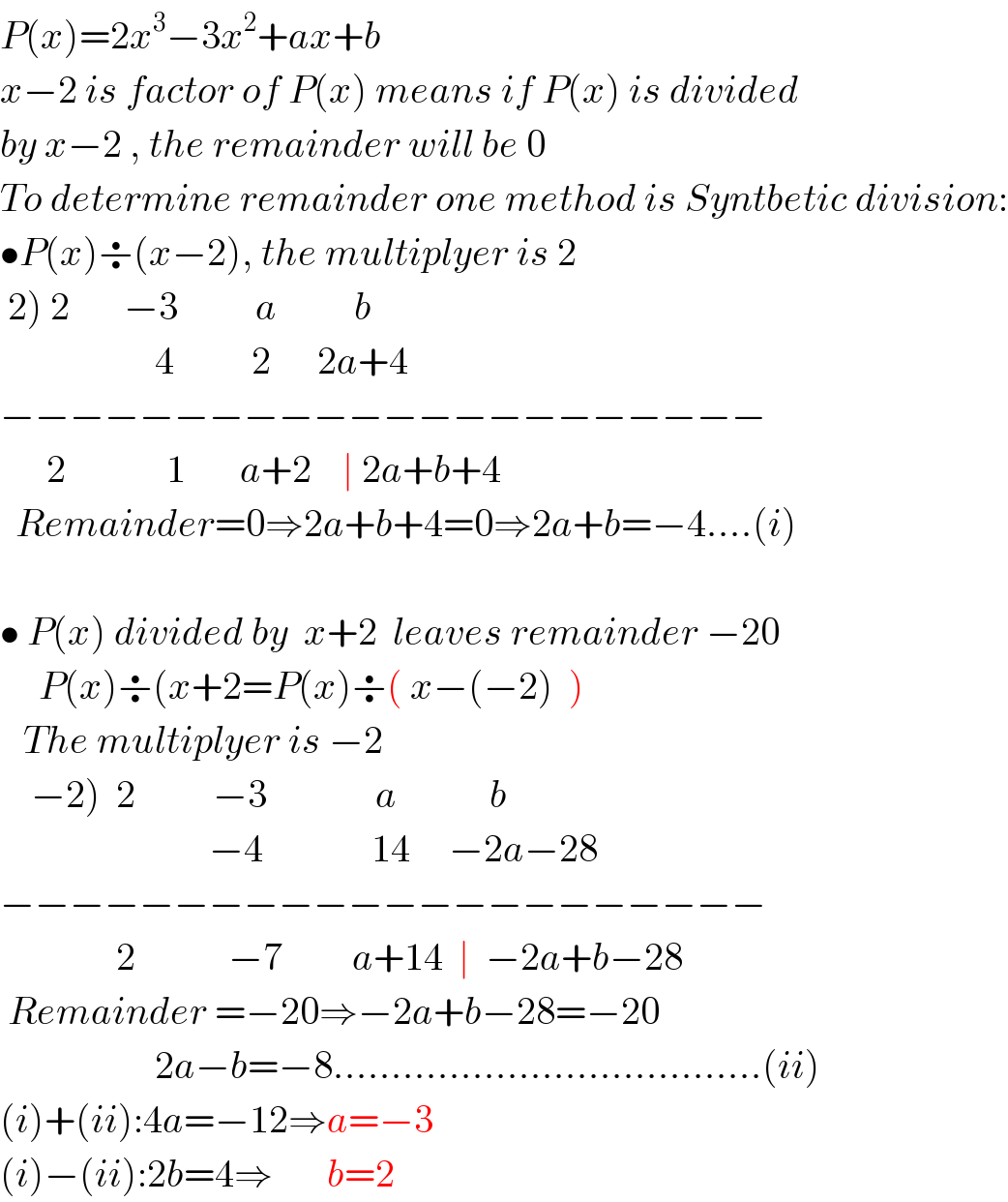
Question Number 6436 by sanusihammed last updated on 27/Jun/16

Answered by Rasheed Soomro last updated on 28/Jun/16

$${P}\left({x}\right)=\mathrm{2}{x}^{\mathrm{3}} −\mathrm{3}{x}^{\mathrm{2}} +{ax}+{b} \\ $$$${x}−\mathrm{2}\:{is}\:{factor}\:{of}\:{P}\left({x}\right)\:{means}\:{if}\:{P}\left({x}\right)\:{is}\:{divided} \\ $$$${by}\:{x}−\mathrm{2}\:,\:{the}\:{remainder}\:{will}\:{be}\:\mathrm{0} \\ $$$${To}\:{determine}\:{remainder}\:{one}\:{method}\:{is}\:{Syntbetic}\:{division}: \\ $$$$\bullet{P}\left({x}\right)\boldsymbol{\div}\left({x}−\mathrm{2}\right),\:{the}\:{multiplyer}\:{is}\:\mathrm{2} \\ $$$$\left.\:\mathrm{2}\right)\:\mathrm{2}\:\:\:\:\:\:\:−\mathrm{3}\:\:\:\:\:\:\:\:\:\:{a}\:\:\:\:\:\:\:\:\:\:{b} \\ $$$$\:\:\:\:\:\:\:\:\:\:\:\:\:\:\:\:\:\:\:\:\mathrm{4}\:\:\:\:\:\:\:\:\:\:\mathrm{2}\:\:\:\:\:\:\mathrm{2}{a}+\mathrm{4} \\ $$$$−−−−−−−−−−−−−−−−−−−−−− \\ $$$$\:\:\:\:\:\:\mathrm{2}\:\:\:\:\:\:\:\:\:\:\:\:\:\mathrm{1}\:\:\:\:\:\:\:{a}+\mathrm{2}\:\:\:\:\mid\:\mathrm{2}{a}+{b}+\mathrm{4} \\ $$$$\:\:{Remainder}=\mathrm{0}\Rightarrow\mathrm{2}{a}+{b}+\mathrm{4}=\mathrm{0}\Rightarrow\mathrm{2}{a}+{b}=−\mathrm{4}....\left({i}\right) \\ $$$$ \\ $$$$\bullet\:{P}\left({x}\right)\:{divided}\:{by}\:\:{x}+\mathrm{2}\:\:{leaves}\:{remainder}\:−\mathrm{20} \\ $$$$\:\:\:\:\:{P}\left({x}\right)\boldsymbol{\div}\left({x}+\mathrm{2}={P}\left({x}\right)\boldsymbol{\div}\left(\:{x}−\left(−\mathrm{2}\right)\:\:\right)\right. \\ $$$$\:\:\:{The}\:{multiplyer}\:{is}\:−\mathrm{2} \\ $$$$\left.\:\:\:\:−\mathrm{2}\right)\:\:\mathrm{2}\:\:\:\:\:\:\:\:\:\:−\mathrm{3}\:\:\:\:\:\:\:\:\:\:\:\:\:\:{a}\:\:\:\:\:\:\:\:\:\:\:\:{b} \\ $$$$\:\:\:\:\:\:\:\:\:\:\:\:\:\:\:\:\:\:\:\:\:\:\:\:\:\:\:−\mathrm{4}\:\:\:\:\:\:\:\:\:\:\:\:\:\:\mathrm{14}\:\:\:\:\:−\mathrm{2}{a}−\mathrm{28} \\ $$$$−−−−−−−−−−−−−−−−−−−−−− \\ $$$$\:\:\:\:\:\:\:\:\:\:\:\:\:\:\:\mathrm{2}\:\:\:\:\:\:\:\:\:\:\:\:−\mathrm{7}\:\:\:\:\:\:\:\:\:{a}+\mathrm{14}\:\:\mid\:\:−\mathrm{2}{a}+{b}−\mathrm{28} \\ $$$$\:{Remainder}\:=−\mathrm{20}\Rightarrow−\mathrm{2}{a}+{b}−\mathrm{28}=−\mathrm{20} \\ $$$$\:\:\:\:\:\:\:\:\:\:\:\:\:\:\:\:\:\:\:\:\mathrm{2}{a}−{b}=−\mathrm{8}.....................................\left({ii}\right) \\ $$$$\left({i}\right)+\left({ii}\right):\mathrm{4}{a}=−\mathrm{12}\Rightarrow{a}=−\mathrm{3} \\ $$$$\left({i}\right)−\left({ii}\right):\mathrm{2}{b}=\mathrm{4}\Rightarrow\:\:\:\:\:\:\:{b}=\mathrm{2} \\ $$
Commented by sanusihammed last updated on 27/Jun/16

$${Thanks}\:{so}\:{much} \\ $$
